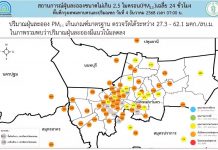
The Ministry of Natural Resources and Environment has expressed deepening concerns over the devastating impact of fires on Thailand’s wild tigers, and urged action to protect and preserve the habitat of these top predators.
Addressing the “Move Forward to Sustainable Tiger Conservation” event, Permanent Secretary Jatuporn Buruspat commended Thailand’s efforts to safeguard wild tiger populations. The kingdom had made significant commitments under the St Petersburg Declaration on Tiger Conservation, along with 12 other nations, to preserve and double the tiger population by 2022.
Positive results have been achieved through the concerted efforts of forest officials and stakeholders, with the Department of National Parks, Wildlife and Plant Conservation reporting an increase in tiger numbers from 130-160 in 2020 to 148-189 in 2022.
Thungyai-Huai Kha Khaeng Wildlife Sanctuary has emerged as the largest habitat for tigers in Thailand, hosting 103-131 of the magnificent felines. Following closely was Tab Lan National Park in Prachin Buri province with 15-23 tigers, the Western Forest Complex, including Mae Wong, Khlong Lan, and Khlong Wang Chao national parks, and the Ung Phang Wildlife Sanctuary, which is home to 16-21 tigers.
To monitor these populations, Jatuporn said officials have employed trap cameras in 1,200 locations across 28 conservation forests. However, these efforts face a grave threat in the form of climate change. The increasing frequency of longer droughts and limited food sources, exacerbated by man-made forest fires, are posing significant challenges to tiger habitats.
In response, the Department of National Parks, Wildlife and Plant Conservation has launched a national action plan for tiger preservation from 2022 to 2034. The plan aims to assist tiger populations in various critical areas, including the Western Forest Complex, the Dong Phayayen-Khao Yai Forest Complex, Kaeng Krachan Forest, Phu Khieo-Nam Nao Forest, and Khlong Saeng-Khao Sok Forest. (NNT)






